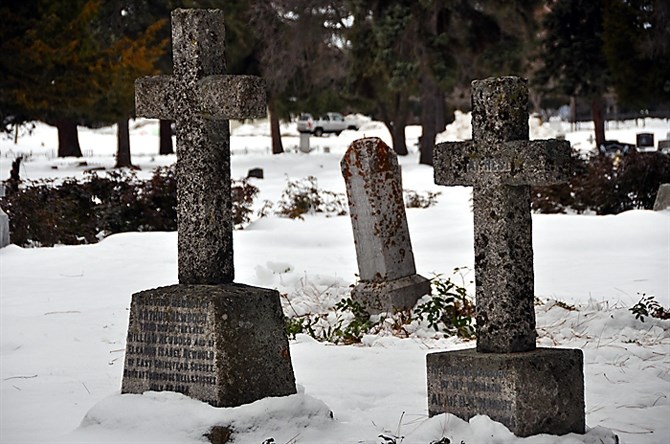
Pioneer section of the Kelowna Memorial Park Cemetery.
Image Credit: John McDonald
January 30, 2015 - 2:34 PM
KELOWNA – Thanks to several emerging trends in the death industry, the question of what happens after you die just got a little more complicated.
With a reputation as a retirement city and 25 per cent of our local population over the age of 60, Kelowna has become something of a last stop for many Canadians. And the city is currently in the first phase of expanding the 52-acre cemetery. Kelowna Memorial Park manager David Gatzke says by 2040 they will likely need to double their capacity.
“We are getting to the point where the available land is filling,” he says. “We are looking at the demands of the community to determine what space we will need.”
The 125-year-old cemetery currently offers only traditional, in-ground burial of either caskets or urns, but there’s also an option for those who want their ashes scattered. Gatzke says they are hoping by this summer to open a new nature trail where ashes can be spread in a park setting for around $150.
“We’re just in the process of registering a scattering trail that we developed on Dilworth Mountain on cemetery property,” he says, adding that a lot of people prefer the cremation option because it is cheaper and has less environmental impact. There is no grass to maintain and the thought of being reunited with nature appeals to many.
The idea of a green burial is not new, but an article by Patrick Langston says Canadians are falling behind when it comes to green alternatives to interment.
“In Great Britain, where the green burial movement was born in the early 1990s, more than 200 green cemeteries operate. The United States, meanwhile, boasts almost 20 cemeteries either in operation or under development; they include the 140-hectare Glendale Memorial Nature Preserve in Florida, which combines a green cemetery and conservation area,” he says in the article. “Here at home we have, by all accounts, nine people buried in officially green cemeteries. They're all in the one-eighth of a hectare dedicated to green burials at Royal Oak Burial Park in Victoria, B.C.”
One reason for this could be that Canada has much more land, but Gatzke says it really comes down to a lack of demand from the public.
“(Green burial) is something we would look at,” he says. “(With traditional burial) you have to fertilize the lawn, you have to water the lawn and you have to drive a mower over it. All those things use energy. With a green burial you have the body interred in an area that is allowed to be more natural. Natural vegetation is encouraged… so you don’t have that perpetual maintenance requirement. The body decomposes naturally into the ground.”
At the moment Royal Oak is the only cemetery in B.C. that accommodates green burials, which eliminate the embalming so it is safer for workers. It also has lower ecological impact since a green burial is done using biodegradable materials that are laid to rest in a more natural setting. Instead of a headstone, family are given GPS coordinates so they can visit the exact spot where their loved one rests.
“It’s a trend that we’re seeing and it’s starting to gain traction,” he says. “It just hasn’t hit Kelowna yet but it’s just a matter of time.
The latest, and possibly greenest option is being put forward by an American group called the Urban Death Project. According to their website, human composting "safely and gently returns the deceased into soil-building material." It is being touted as a practical and sustainable solution to urban cemetery overcrowding. But that idea may be ahead of its time.
“As far as I know there is no legislation that would allow for this type of interment at this time," he says. “I had never heard of human composting before.”
Gatzke says although that particular method is not even on his radar yet, he can see the potential of the admittedly off-putting alternative to traditional, in-ground burial.
“Something like this would be a sustainable option because you’re reusing material and the remains are taking an active process in regeneration,” he says. “If it was my personal project I may have taken a different approach (to calling it human composting). But at the same time it puts it right in your face and it starts the dialogue.”
If the thought of being turned into soil after you die is too much to handle, you can always request your ashes be laid to rest at your favourite spot. This is not legal everywhere though so be sure to check local laws first. And don't do it on a windy day.
To contact the reporter for this story, email Adam Proskiw at aproskiw@infotelnews.ca or call 250-718-0428. To contact the editor, email mjones@infotelnews.ca or call 250-718-2724.
News from © iNFOnews, 2015